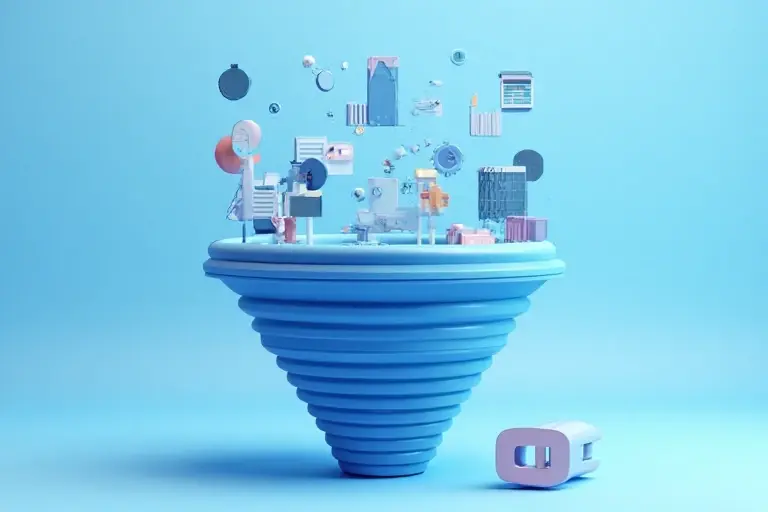
In today’s highly competitive digital landscape, having a solid understanding of the digital marketing funnel is essential for driving customer acquisition, increasing conversions, and fostering brand loyalty. The digital marketing funnel is a powerful concept that helps businesses visualize the customer journey and create strategies tailored to each stage. This step-by-step guide will break down the stages of the funnel and explain how to leverage it effectively for your marketing efforts.
The digital marketing funnel represents the journey that potential customers go through, from first becoming aware of your brand to making a purchase and becoming a loyal customer. It’s often depicted as a funnel because at the top, there are a large number of potential customers, but as they move down the funnel, the number decreases as some drop off at different stages.
The digital marketing funnel consists of several stages that guide the decision-making process of your audience:
Let’s break down each stage of the digital marketing funnel and how to effectively target prospects at each level:
Goal: Introduce your brand to a wide audience and generate awareness.
At the top of the funnel, prospects are just becoming aware of your brand or product. They may not even know they have a need for what you offer yet. The key goal at this stage is to educate and inform your audience.
Strategies to use at the Awareness stage:
Goal: Nurture interest and start engaging with potential customers.
Once prospects are aware of your brand, the next step is to build their interest. At this stage, your audience is actively researching and considering solutions to their problems.
Strategies to use at the Interest stage:
Goal: Foster desire and convert leads into customers.
By the time a potential customer reaches the desire stage, they have a clear understanding of their needs and are evaluating their options. The goal is to create a strong desire for your solution and differentiate your product from competitors.
Strategies to use at the Desire stage:
Goal: Convert leads into paying customers.
At this stage, your prospect is ready to make a purchase or take the desired action. Your job is to ensure the process is seamless, user-friendly, and provides the final push to drive conversions.
Strategies to use at the Action stage:
The key to a successful digital marketing funnel is optimizing each stage to create a seamless experience that guides customers toward taking action.
Understanding the digital marketing funnel is essential for optimizing your marketing efforts and improving conversion rates. By focusing on providing value at each stage of the funnel, businesses can build strong relationships with potential customers, guide them through the decision-making process, and ultimately increase conversions.
If you're looking to deepen your knowledge of Digital Marketing Strategy or SEO and Content Marketing Integration, consider exploring additional resources. Tailoring your strategies to each stage of the funnel can ensure that you remain competitive and successful in today’s ever-evolving digital landscape.
What is the digital marketing funnel?
The digital marketing funnel represents the journey potential customers go through, from awareness to action, helping businesses guide prospects toward conversion.
Why is the awareness stage important in the funnel?
The awareness stage is crucial because it’s where you introduce your brand to a wide audience and create initial interest through content marketing and social media marketing.
What strategies can help convert leads at the desire stage?
Retargeting ads, customer testimonials, and personalized offers are all effective ways to convert leads at the desire stage into customers.
How do I measure the effectiveness of my digital marketing funnel?
Use tools like Google Analytics, A/B Testing, and conversion tracking to measure your funnel’s performance at each stage and identify areas for improvement.
What is the importance of A/B testing in the digital marketing funnel?
A/B Testing in Marketing helps you compare different versions of ads, landing pages, or emails to optimize your funnel and improve conversions.
How does SEO fit into the digital marketing funnel?
SEO plays a key role in the awareness stage by improving your content’s visibility in search engines and driving organic traffic to your website.
What role does mobile marketing play in the funnel?
Mobile Marketing Strategy is vital as more users interact with brands via smartphones. Optimizing your funnel for mobile devices can improve customer engagement and conversion rates.
How can I enhance the customer experience in the digital marketing funnel?
Personalize your content, offer helpful resources, and make the buying process as smooth as possible to enhance the customer experience.
What is the difference between the interest and desire stages?
The interest stage involves educating and nurturing leads, while the desire stage focuses on creating a strong emotional connection and differentiation from competitors.
How do I keep prospects engaged through the funnel?
Continuously provide valuable content, retargeting ads, and personalized offers at each stage to keep prospects engaged until they reach the conversion point.